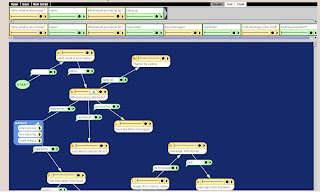Camelot Village-affordable country living…yet you can’t find your way.
I always thought this sign was so esoteric. Under the reflection of this project I am convinced it is. This development boasts “country living”, right off a main highway. Really? I think they use the word “affordable” first, before country living, to attract attention. It is also ironic because just to the left of the frame you can see the side of the sign for Hillcrest Commercial Park. That doesn’t seem to signify country living-right next to a commercial park. Irony again. (The commercial park is really storage units that reside on the right of the driveway into Camelot village development). In terms of sign design, green on white is one of the high visibility color recommendations (esigns). The sign is lit up at night and very clear. The landscaping around the sign is attractive and does draw the eye to it.
Signs
For people looking to move into Camelot Village, their first stop is the sales office. The sales office is on the left, but it looks like any other house in the development. The sales office sign points straight down the road. In front of the office, there are no signs indicating it is the office. The next building that is visible is this:
Which again is not signed and is actually the mail boxes for the residents. If you drive past this building all that remains are homes. It becomes clear after driving for a while that the other possibility for the sales office is the house in the front of the development. “People need information to make and execute decisions” (Passini, P. 89). This is the basic principle of wayfinding. The first experience in the development results in frustration and difficulty making sense of where things are.
Maps
The directory map makes one thing clear; this is going to be a confusing journey. As you can see the colors indicate multiple streets. The red indicates seven different streets. “Color is an effective way to convey differentiation” (Baer, p. 90). In this case, the color only differentiates sections of the village instead of signifying different streets. Well, hopefully the streets and appropriately marked.
Street confusion
As you drive down the first street in the villiage, you come upon this intersection, that is the main street merging to the left and right, while it continues on straight ahead, except on a slant. The sign to the left is the only street sign and is obscured by the branches. If you chose to go right, you come upon a sign that is all the way past the intersection.
To the slight left of the street sign is the continuation of the main street that is not a straight line, but a curved road around a home. This picture shows the view from the other direction.
The confusion within the development continues all the way through, with missing signs, unclear directions, few marked houses, and streets that seemingly end before a marked start of the next one.
The street ends where?
Most street intersections look like this. There is one sign marking the cross street (the street to the left) while the street you are on is not identified. The road curves off to the right and starts a new road. There is no sign at the end to signify the street changed and the houses just before the road curves are actually assigned the new streets address.
Audience
This development is poorly signed and the maps are difficult at best. The audience for these directions cannot be prospective tenants. Even people who move in take a few months to fully understand where streets start and stop. Some of the older tenants never quite figure out which street merges into another one.
Design and Structure
The design of the development, the placement of homes and streets, actually is laid out very well. The structure makes sense and logically, seems to make navigational sense. The homes all are set on the property in a logical way considering the homes around it. The streets in the back, on the borders of the development, have a wooded area and storage units. The storage units are not obtrusive and are hidden on the edges of the property. The mail unit and sales office are in logical places and easy to get to. The basket ball court is centrally located and on a main street. The navigational difficulty is the signage and street directory. The village developers paid little attention to the users of the village and failed to conduct usability tests. The signs and map certainly fail to meet user-centered design standards.
References
Baer, Kim. Information Design Workbook. Beverly, MA: Rockport Publishers, 2008. Print.
Passini, Romedi. ”Sign-Posting Information Design” Information Design. Ed. Robert Jacobson. London: MIT, 2000. 83-98. Print.
















